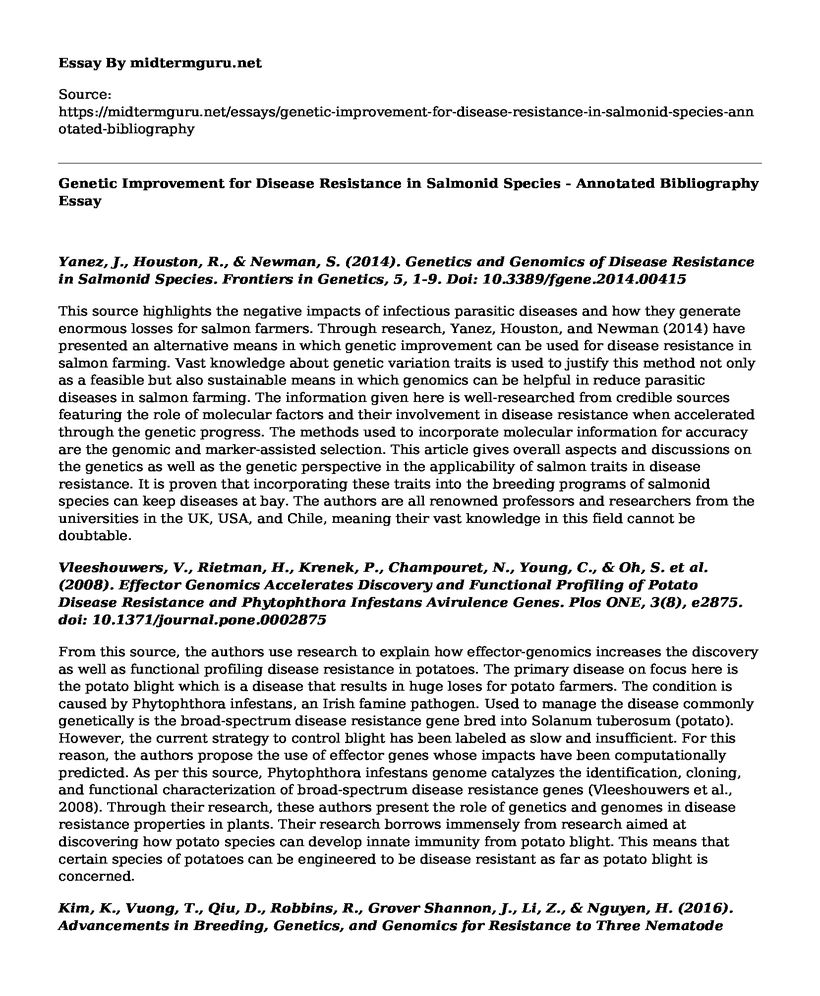Yanez, J., Houston, R., & Newman, S. (2014). Genetics and Genomics of Disease Resistance in Salmonid Species. Frontiers in Genetics, 5, 1-9. Doi: 10.3389/fgene.2014.00415
This source highlights the negative impacts of infectious parasitic diseases and how they generate enormous losses for salmon farmers. Through research, Yanez, Houston, and Newman (2014) have presented an alternative means in which genetic improvement can be used for disease resistance in salmon farming. Vast knowledge about genetic variation traits is used to justify this method not only as a feasible but also sustainable means in which genomics can be helpful in reduce parasitic diseases in salmon farming. The information given here is well-researched from credible sources featuring the role of molecular factors and their involvement in disease resistance when accelerated through the genetic progress. The methods used to incorporate molecular information for accuracy are the genomic and marker-assisted selection. This article gives overall aspects and discussions on the genetics as well as the genetic perspective in the applicability of salmon traits in disease resistance. It is proven that incorporating these traits into the breeding programs of salmonid species can keep diseases at bay. The authors are all renowned professors and researchers from the universities in the UK, USA, and Chile, meaning their vast knowledge in this field cannot be doubtable.
Vleeshouwers, V., Rietman, H., Krenek, P., Champouret, N., Young, C., & Oh, S. et al. (2008). Effector Genomics Accelerates Discovery and Functional Profiling of Potato Disease Resistance and Phytophthora Infestans Avirulence Genes. Plos ONE, 3(8), e2875. doi: 10.1371/journal.pone.0002875
From this source, the authors use research to explain how effector-genomics increases the discovery as well as functional profiling disease resistance in potatoes. The primary disease on focus here is the potato blight which is a disease that results in huge loses for potato farmers. The condition is caused by Phytophthora infestans, an Irish famine pathogen. Used to manage the disease commonly genetically is the broad-spectrum disease resistance gene bred into Solanum tuberosum (potato). However, the current strategy to control blight has been labeled as slow and insufficient. For this reason, the authors propose the use of effector genes whose impacts have been computationally predicted. As per this source, Phytophthora infestans genome catalyzes the identification, cloning, and functional characterization of broad-spectrum disease resistance genes (Vleeshouwers et al., 2008). Through their research, these authors present the role of genetics and genomes in disease resistance properties in plants. Their research borrows immensely from research aimed at discovering how potato species can develop innate immunity from potato blight. This means that certain species of potatoes can be engineered to be disease resistant as far as potato blight is concerned.
Kim, K., Vuong, T., Qiu, D., Robbins, R., Grover Shannon, J., Li, Z., & Nguyen, H. (2016). Advancements in Breeding, Genetics, and Genomics for Resistance to Three Nematode Species in Soybean. Theoretical and Applied Genetics, 129(12), 2295-2311. doi: 10.1007/s00122-016-2816-x
In this source, Kim et al. (2016) have presented the advancements inbreeding with the incorporation of genetics and genomics in how nematode soybean species can become disease resistant. The authors have done incredible work in their research in which various components, including molecular biology, genetic analysis, and genome approaches are used in the understanding of resistance by nematodes through genetic control. In this article, three species of nematodes are used, including root-knot (RKN-Meloidogyne incognita), soybean cysts (SCN-Heterodera glycine) and reniform(RN-Rotylenchulus reniformis). These are the most destructive, and their spread worldwide has been widely reported by farmers and crops scientists. The authors indicate that host-plant disease resistance capabilities have aided the partial control of these diseases. The main focus of this research includes the genomic studies, genetics, as well as breeding techniques that have been used for the past two decades. The authors borrow mostly from genetic architectural sources and molecular properties of plant traits. It is given that various engineering and genetic sequencing techniques can be useful in developing disease resistance. As the nematode species continue to overcome the host resistance, the authors suggest continuous identification and use of new genes that can resist diseases that affect soybeans.
References
Kim, K., Vuong, T., Qiu, D., Robbins, R., Grover Shannon, J., Li, Z., & Nguyen, H. (2016). Advancements in Breeding, Genetics, and Genomics for Resistance to Three Nematode Species in Soybean. Theoretical and Applied Genetics, 129(12), 2295-2311. doi: 10.1007/s00122-016-2816-x
Vleeshouwers, V., Rietman, H., Krenek, P., Champouret, N., Young, C., & Oh, S. et al. (2008). Effector Genomics Accelerates Discovery and Functional Profiling of Potato Disease Resistance and Phytophthora Infestans Avirulence Genes. Plos ONE, 3(8), e2875. doi: 10.1371/journal.pone.0002875
Yanez, J., Houston, R., & Newman, S. (2014). Genetics and Genomics of Disease Resistance in Salmonid Species. Frontiers in Genetics, 5, 1-9. Doi: 10.3389/fgene.2014.00415
Cite this page
Genetic Improvement for Disease Resistance in Salmonid Species - Annotated Bibliography. (2023, Feb 11). Retrieved from https://midtermguru.com/essays/genetic-improvement-for-disease-resistance-in-salmonid-species-annotated-bibliography
If you are the original author of this essay and no longer wish to have it published on the midtermguru.com website, please click below to request its removal:
- Essay Sample on Effects of Parenting on Health
- Paper Example on Health Problems among Adolescents, Young Adults, and Adults
- Legalize or Ban Euthanasia? - Research Paper
- My Fundamentals of Nursing Evolution - Essay Sample
- Addressing Nursing Shortage & Improving US Health Care - Essay Sample
- Coronary Artery Diseases: Risk of Venous Disorder - Essay Sample
- Jensen Pharma Announces 3-Month Investigation of Dekanor - Essay Sample







